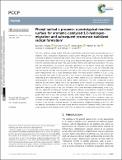Phenyl radical + propene: a prototypical reaction surface for aromatic-catalyzed 1,2-hydrogen-migration and subsequent resonance-stabilized radical formation
Author(s)
Buras, Zachary; Chu, Te-Chun; Jamal, Adeel; Yee, Nathan Wa-Wai; Middaugh, Joshua Eugene; Green Jr, William H; ... Show more Show less
Downloadc8cp01159a.pdf (7.100Mb)
PUBLISHER_CC
Publisher with Creative Commons License
Creative Commons Attribution
Terms of use
Metadata
Show full item recordAbstract
The C[subscript 9]H[subscript 11] potential energy surface (PES) was experimentally and theoretically explored because it is a relatively simple, prototypical alkylaromatic radical system. Although the C[subscript 9]H[subscript 11] PES has already been extensively studied both experimentally (under single-collision and thermal conditions) and theoretically, new insights were made in this work by taking a new experimental approach: flash photolysis combined with time-resolved molecular beam mass spectrometry (MBMS) and visible laser absorbance. The C[subscript 9]H[subscript 11] PES was experimentally accessed by photolytic generation of the phenyl radical and subsequent reaction with excess propene (C[subscript 6]H[subscript 5] + C[subscript 3]H[subscript 6]). The overall kinetics of C[subscript 6]H[subscript 5] + C[subscript 3]H[subscript 6] was measured using laser absorbance with high time-resolution from 300 to 700 K and was found to be in agreement with earlier measurements over a lower temperature range. Five major product channels of C[subscript 6]H[subscript 5] + C[subscript 3]H[subscript 6] were observed with MBMS at 600 and 700 K, four of which were expected: hydrogen (H)-abstraction (measured by the stable benzene, C[subscript 6]H[subscript 6], product), methyl radical (CH[subscript 3])-loss (styrene detected), H-loss (phenylpropene isomers detected) and radical adduct stabilization. The fifth, unexpected product observed was the benzyl radical, which was rationalized by the inclusion of a previously unreported pathway on the C[subscript 9]H[subscript 11] PES: aromatic-catalysed 1,2-H-migration and subsequent resonance stabilized radical (RSR, benzyl radical in this case) formation. The current theoretical understanding of the C[subscript 9]H[subscript 11] PES was supported (including the aromatic-catalyzed pathway) by quantitative comparisons between modelled and experimental MBMS results. At 700 K, the branching to styrene + CH[subscript 3] was 2-4 times greater than that of any other product channel, while benzyl radical + C[subscript 2]H[subscript 4] from the aromatic-catalyzed pathway accounted for ∼10% of the branching. Single-collision conditions were also simulated on the updated PES to explain why previous crossed molecular beam experiments did not see evidence of the aromatic-catalyzed pathway. This experimentally validated knowledge of the C[subscript 9]H[subscript 11] PES was added to the database of the open-source Reaction Mechanism Generator (RMG), which was then used to generalize the findings on the C[subscript 9]H[subscript 11] PES to a slightly more complicated alkylaromatic system.
Date issued
2018-04Department
Massachusetts Institute of Technology. Department of Chemical EngineeringJournal
Physical Chemistry Chemical Physics
Publisher
Royal Society of Chemistry (RSC)
Citation
Buras, Zachary J., Te-Chun Chu, Adeel Jamal, Nathan W. Yee, Joshua E. Middaugh, and William H. Green. “Phenyl Radical + Propene: a Prototypical Reaction Surface for Aromatic-Catalyzed 1,2-Hydrogen-Migration and Subsequent Resonance-Stabilized Radical Formation.” Physical Chemistry Chemical Physics 20, no. 19 (2018): 13191–13214. © 2018 the Owner Societies
Version: Final published version
ISSN
1463-9076
1463-9084